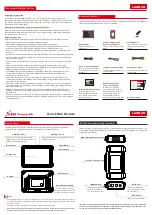
Operation
6
313291D
Operation
Pressure Relief Procedure
1.
Shut off the air supply to the tank.
2.
Lift the pressure relief valve ring (1b) to open it. See
F
3.
When no air is escaping through the valve, unscrew
the wing nuts and remove the tank cover (H).
4.
Leave the pressure relief valve open until you have
reinstalled the cover.
Fill the Tank
1.
Follow the manufacturer’s recommendations to pre-
pare the paint or other coating. Strain the paint to
remove particles or sediment that could clog the
spray gun and hose.
2.
Follow Pressure Relief Procedure (above).
3.
Unscrew the wing nuts and remove the cover (H).
4.
Fill the tank with the paint. Leave at least 2 in.
(51 mm) between the paint level and the tank cover.
A one gallon paint can may be placed inside the
pressure tank.
5.
Install the tank cover and evenly hand tighten the
wing nuts. Overtightening the nuts may cause the
gasket (1c) to squeeze out. The gasket is needed to
properly seal the cover and tank.
Adjust the Air Regulators
Turn the air regulator T handle counterclockwise all the
way to off. Turn on the master air supply. Adjust the air
regulators to the required pressure. Always use the low-
est pressure necessary to obtain the desired results.
Lower pressures help reduce spray tip wear.
Vertical and Horizontal Reach
Do not operate the spray gun more than 10 ft (3.1 m)
above the paint tank. Longer lengths of air and paint
hose may be used between the pressure tank and the
spray gun for greater horizontal working range.
Pressure tanks remain pressurized until pressure is
manually relieved.
NOTICE
Overfilling or tipping the tank causes the paint to
enter the air line and clog the regulator, hose, and
gun. Do not exceed the 2.5 gallon tank capacity.
F
IG
. 5
To reduce the risk of overpressurizing the tank, which
could result in component rupture and cause serious
injury, never exceed 50 psi (350 kPa, 3.5 bar) maxi-
mum air input pressure to the tank.
ti12987a
H
1b
1c




























